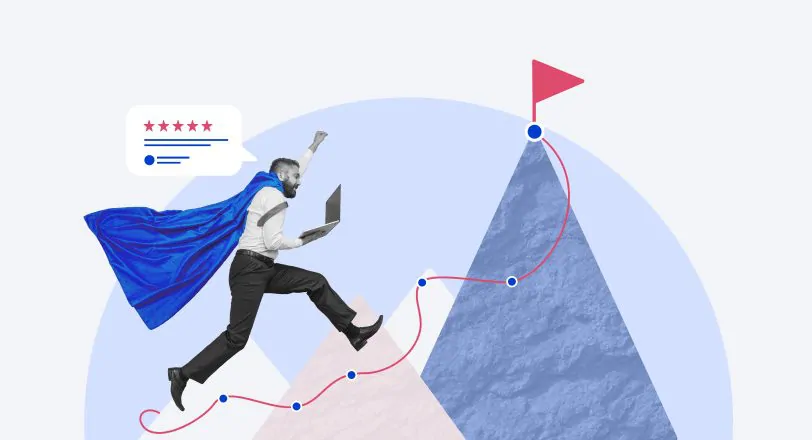8 Role-Playing Scenarios for Customer Service Training

Customer service mistakes are dangerous. They can cost your company a great deal of money.
According to a report by Forrester, poor customer experience leads to consumers abandoning intended purchases that can be translated to an estimated $62 billion in lost sales in the US per year. With great support comes a strong customer relationship. And one sure way to make it great is by teaching your team about possible customer service scenarios and how to handle them.
In difficult customer service scenarios, it’s hard to come up with the magic answer or solution. But the good news is that most of them are repetitive and fall into a finite number of categories. No matter what customer service situation you’re dealing with, role-playing is the best way to train new employees and provide continuous professional development. In this article, we’re going to provide you with some of the most common role-playing scenarios and share our insights on how to move customer service training online with iSpring Suite.
What Are Role-Playing Scenarios?
Role-playing scenarios are scenarios in which two or more people act out in specific roles. Usually, a senior member of your company (e.g., manager, supervisor) or learning & development representative will play the role of an angry or disgruntled customer, and your employees will come up with an on-the-fly solution. Based on their responses, the trainer will be able to bridge knowledge gaps and/or point them in the right direction.
As a company owner or hiring manager, you can also use role-play scenarios during the onboarding process to determine how a newcomer would approach typical situations in your company. Simply stage a scene and give them time to think of how they’d react. Their response will determine whether they’d be a good fit, whether they’re knowledgeable and experienced, or whether you should pass on them.
However or whenever you use them, role-play customer service scenarios can help you train employees and, therefore, improve customer service in your organization.
Benefits of Role-Playing
Many businesses use role-playing as a part of their training programs. Why? Check out some of the benefits of role-playing:
- Building confidence for actual situations
- Finding the best approaches
- Fewer mistakes in real life
- Better communication skills
- Creative problem solving
How to Use Role-Play
If you’re thinking about adding role-play activities to your training sessions but aren’t sure how to do this, check out this 5-step guide:
Step 1: Introduce the issue
Before you start acting out your role-play, gather people together in a classroom or any other place you use for training and introduce the topic to them. Your role-play can be about everyday situations or unusual cases, depending on the goals you set. Provide the participants with instructions on the training process. You can also explain why you decided to address the issue, the purpose of the role-play, what results you hope to achieve by the end of the session, and let trainees discuss the issue to warm them up.
Step 2: Provide details
Once you complete the preface to the session, provide trainees with background information, more details about the issue, the scenario, and the ways to act during the role-play. Make sure to give enough details for the imaginary situation to make it feel like an actual one.
Step 3: Assign roles
Introduce the characters involved in the scenario and assign their roles to trainees. For example, if you act out the impatient customer scenario, you will have two roles on different sides of an argument: a customer and a representative. Make sure trainees understand what their role and tasks are according to the assignment.
Step 4: Act out a scenario
Now, let the trainees act out their roles while others look on. You might advise your trainees to intensify the situation gradually. For example, an impatient customer might start off calm and then get irritated and angry. While this depends on a particular case, such an approach lets trainees practice various social skills and situations, which makes the session more effective and employees more productive in real-life situations.
Step 5: Discuss the experience
Regardless of the outcome of the role-play, it is essential to discuss it with all the participants. If a person failed to find the correct approach, invite trainees to analyze the reasons, such as lack of persuasion or too aggressive communication, and suggest different strategies. And if a person found the right solution for the issue, discuss what made it effective and whether there could be alternative solutions as well. Different perspectives can lead to truly great solutions that will drive your company to success, so make sure to listen to all the participants in the training session. This type of training is all about collaboration and teamwork.
The 8 Most Popular Role-Playing Scenarios
Here are 8 scenarios that are typical across the board in customer service:
- The impatient customer
- The dissatisfied customer
- The angry customer
- The frugal customer
- When you don’t know the answer
- The defective-product customer
- The feature-request customer
- When a customer violates your terms of service
Let’s take a closer look at each of them.
Role-Playing Scenario #1 – The Impatient Customer
A customer ordered a product online, and they still haven’t received it after the expected delivery date. The customer is irritated and demanding a refund. While the late delivery might not be your fault, and the customer’s attitude might trigger defensiveness, so the important thing to do is to apologize and assure them that you’re working on resolving the issue. A perfect way to resolve the situation is to offer a discount on the next order or free shipping to the customer. For example:
Customer: To whom it may concern, I ordered a product 2 weeks ago, and it was supposed to turn up 3 days ago. What’s going on?
Representative: My sincerest apologies. Late deliveries can be a real pain. I assure you that we’re doing everything possible to resolve this issue for you. And as an apology, we’re happy to give you a 10% discount on your next purchase.
Role-Playing Scenario #2 – The Dissatisfied Customer
A customer has bought a new gaming computer and claims that it doesn’t comply with the characteristics specified by the manufacturer. Remember that not all is lost in this scenario. Instead of simply issuing a refund, try to find out the nature of the dissatisfaction and recommend a better alternative.
Customer: Hi there, I bought this computer 3 days ago, but it doesn’t perform as well as described on the website. I chose my platform and the games I would be playing, but the computer doesn’t come anywhere close to hitting the frame rate that the manufacturer said it would even on the lowest graphic settings. I’d like to return it.
Representative: Hey there! No problem. You can return it or exchange it for a different computer. Many of our customers are serious gamers, and they speak highly of this (other) model. Why don’t you demo it and tell us what you think?
Customer: Wow! This computer’s great! I hope I won’t regret it if I do an exchange.
Role-Playing Scenario #3 – The Angry Customer
An angry customer is yelling over the phone about a software malfunction that is jeopardizing an important project. The customer’s emotions have gotten the best of him/her. Try calming them down by apologizing and showing empathy for his/her situation – regardless of whether the company or customer is at fault. Then, attempt to resolve the issue.
Customer: This isn’t the first time your software has glitched out on me! I pay a lot of money to use this presentation tool, and if I don’t complete the project by tomorrow, I risk losing a major client!
Scenario 1: The issue is on the client’s side
Representative: Sorry you’re experiencing this issue. That must be very frustrating. I’ve looked into your account and the problem seems to be that you’re using an older version of the software. I’ve sent you a link to the latest version. Please download it, try again, and notify us if you run into any issues. We’re always here to help.
Scenario 2: The company’s at fault
Representative: Sorry you’re experiencing this issue. There’s a system-wide server error, but we can assure you that the issue will be fixed as soon as possible. Nonetheless, we understand the inconvenience this is causing you. As an apology, please accept this 50% discount on your next month’s subscription fee.
Role-Playing Scenario #4 – The Frugal Customer
A customer is keen on purchasing your product but has expressed dismay at the price. While prices are normally fixed, rather than simply dismissing the customer’s request with a “too bad, so sad” attitude, calmly justify the price by describing the product’s unique features. And if possible, find another way to ease the financial load, such as a free add-on or financing.
Customer: Hi there. I’d love to purchase this vehicle, but its price is well beyond my budget, so I’ll have to pass.
Representative: I understand that the price is steep for you, but this car is durable and fuel-efficient – it achieves up to 48 MPG on the highway. So the price is reasonable. Over time, if you count the money you save in gas and car repairs, you’ll see that the vehicle practically pays for itself! However, what we can offer you is 0% financing for the next 5 years. Would that work for you?
Role-Playing Scenario #5 – When You Don’t Know the Answer
A customer is keen on one of your top-selling products and wants to know when it’ll be back in stock. If you simply say “I don’t know” or “Check back later”, they might dismiss the purchase altogether. The best thing to do here is to assure them that you’ll get back to them with an answer. And before they potentially decide to go elsewhere, recommend alternative products that are in stock. For example:
Customer: Hello! I’m very interested in buying one of your down-feather jackets. The price is right, and it’s exactly what I’m looking for. But unfortunately, it is out of stock. Do you know when you’ll be getting more?
Representative: Hi there. We recently ran out, and unfortunately, we’re not sure when our new shipment will come in as it depends on our supplier. However, in the meantime, here is a link to our similar brands. Please feel free to browse them. Either way, we will reach out to our supplier and notify you as soon as we receive a response. What is the best way to contact you?
Role-Playing Scenario #6 – The Defective-Product Customer
A customer comes into your store complaining about a recent purchase that is defective in some form. Rather than jumping to conclusions that effectively place the blame on the customer, try to empathize with them, as they’re likely disappointed over a purchase that they put a lot of thought into. The good news is that, in these situations, they’re usually looking for an exchange versus a refund. To seal the deal, show empathy by apologizing to the customer and providing them with an immediate solution.
Customer: Good afternoon! I recently purchased a swivel chair from your store, but every time I pivot, it makes a loud and bothersome squeak.
Representative: Yikes. We’re sorry to hear that. That must be really distracting. We don’t hear of this issue too often, so it might be due to a manufacturing defect. We’d be more than happy to send you a new one right away.
Role-Playing Scenario #7 – The Feature-Request Customer
A customer contacts your technical/support team with ideas on how you can improve your product. Customers often provide invaluable insights that can help your company thrive and grow. Whether or not you can fulfill the request, it’s important to first thank the customer for the time they’ve taken to share it with you, and explain how and when you plan to implement it, or why you won’t be able to.
Customer: Hi! I’ve been using your product for a few months now and so far, everything is great! However, I feel like it is lacking in branding customization options. Will you be able to add more functionality in the next update?
Scenario 1: Your company can add more functionality
Representative: Hello there! Thanks for your feature request. We’re always open to new ideas from our customers to improve our product. To help us prioritize our resources, please tell us what specific branding flexibilities you are looking for. Then I’ll share this information with our dev team.
Scenario 2: Your company can’t add more functionality
Representative: Hello there! Thanks for your feature request, but due to limited resources, we are unable to implement it in the near future. That being said, many of our customers have made similar requests. So we’re taking it very seriously. For the time being, we’ll add it to our backlog, and you will definitely be notified when we’re ready to implement more branding options.
For the time being, our platform integrates many WordPress plugins that allow for more flexibility. Here’s a link to some of the most commonly used plugins. Please feel free to contact us if you need any help.
Role-Playing Scenario #8 – When a Customer Violates Your Terms of Service
A customer has purchased a VPN service and – against the terms of services –has installed it on multiple devices. While it can be awkward to tell a paying customer that they’re in breach of your terms of service, there’s a way to go about it that both gets your point across and preserves their dignity. The key involves refraining from dubious assumptions. You need to determine their needs and attempt to fulfill them. For example:
Representative: Dear customer, we’re reaching out to you because we’ve noticed that you’ve installed our VPN software on multiple devices while registered with our single-device package. Were you planning on upgrading to one of our multi-device packages instead? Please let us know, and we’ll set you up with the right package for your needs.
Since these scenarios are typical for all customer service managers, it makes sense to automate staff training and deliver it online.
Online Customer Service Scenarios
You can convert customer service scenarios into dialog simulations by using a course authoring tool such as iSpring Suite. A dialog simulation is an interactive exercise that imitates a real conversation with a customer and helps people master communication skills without any risk of damaging the relationship with a client.
iSpring Suite
Fully-stocked eLearning authoring toolkit for PowerPoint. No training required to start!
The first step in building role-play scenarios is visualizing them as a flowchart. For example, you can create a mind map online by using Coggle.

As exemplified in the above mind map, each type of scenario branches into multiple options. For example, if a customer’s having an issue with a product, the first step to resolving it is determining who’s responsible. As shown above, if it’s a company-side issue, this yields different responses than when it’s a client-side issue. However, how do you express all these different options in a way that allows your employees to naturally navigate this virtual environment?
Well, with iSpring Suite, you can build a dialog tree, a well-organized structure that you can manipulate with one click of a mouse.

To make the conversation even more complex and realistic, you can add locations and characters. You can upload your own images or use the built-in collection. iSpring Content Library offers a large set of characters of different ages, ethnic groups, and professions, and a huge collection of backgrounds suitable for business, manufacturing, education, medicine, and travel situations.
Check out this iSpring demo to get a better idea of what these powerful scenarios look like.
While these dialog simulations might look technologically sophisticated, it’s quite easy to navigate with the right software and guidance. Read our article on how to improve your employees’ communication and negotiation skills using dialog simulations.
The best part of online customer service scenarios is that your employees can deep-dive into a simulation while selecting responses that naturally align with how they’d act in real life. Based on their responses and your predesigned branched scenarios, they’ll be able to experience–risk-free–the positive and negative consequences of their chosen actions and responses, and receive feedback on their progress.
To Sum Up
Customer service is core to the success of any thriving business. You should never underestimate the power of a happy customer, negative press, or word of mouth. The way your employees interact with customers can make or break the reputation of your business. That’s why you should never take employee training for customer service lightly.
Moreover, because people learn best through experience, it’s best to create a virtual environment that’s risk-free, highly immersive, and engaging.
If you’d like to create customer service scenario interview questions and answers, or simulate situations surrounding software troubleshooting, sales techniques, or more, then you can get started today by downloading a free trial of iSpring Suite!











